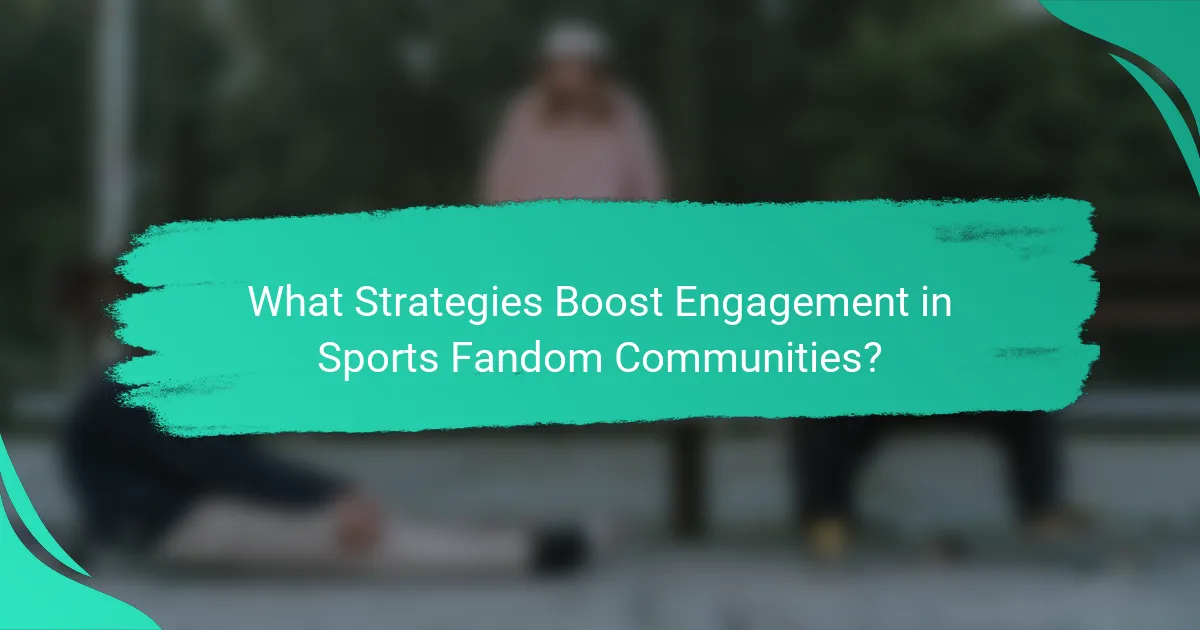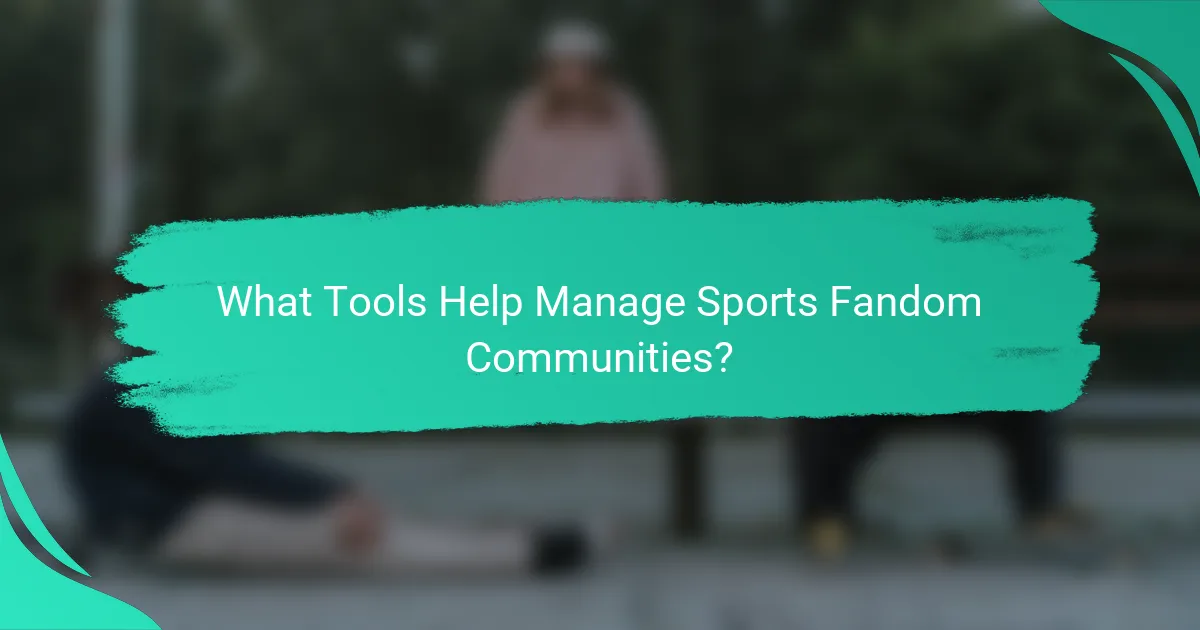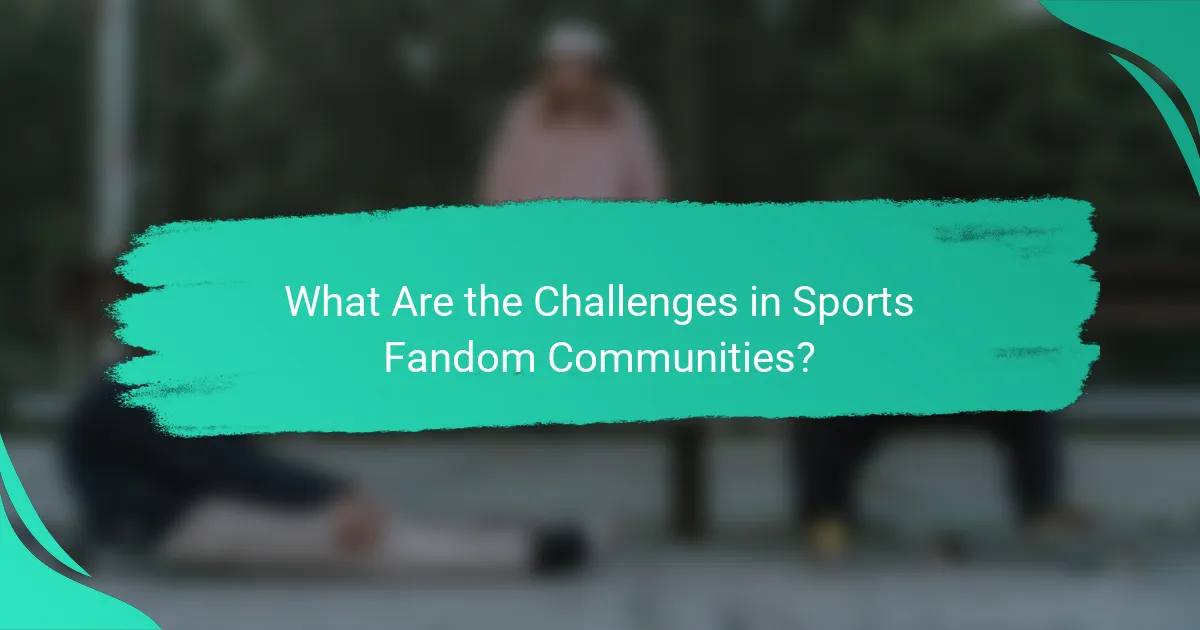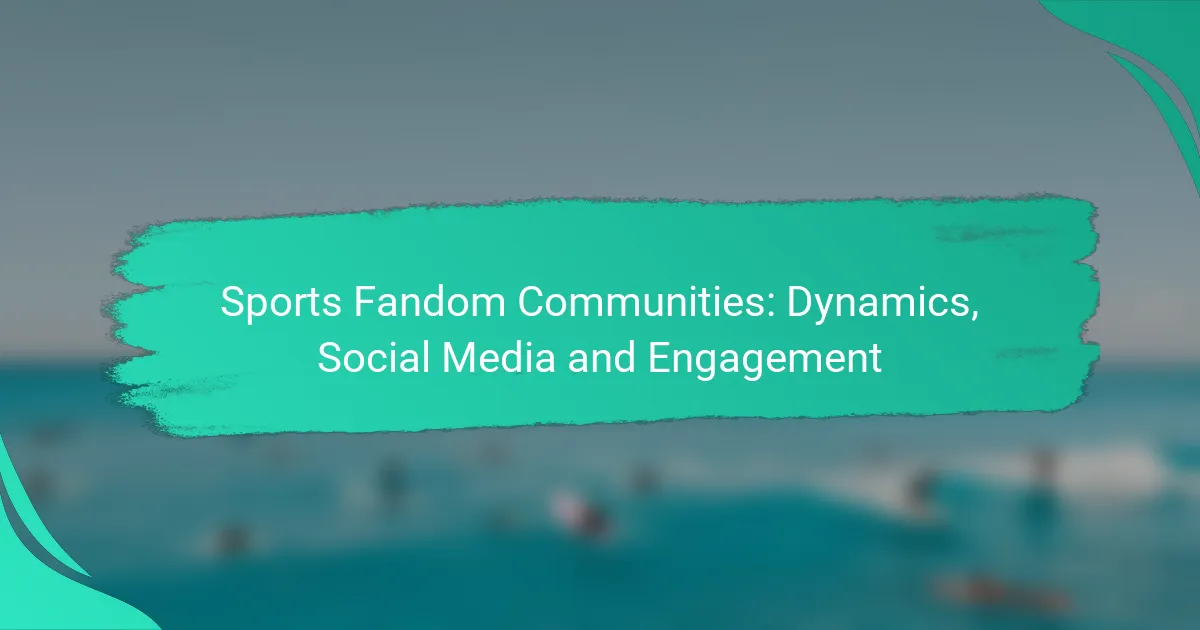Sports fandom communities thrive on social media, providing fans with a platform to engage in lively discussions, share content, and connect with others who share their passion. These communities not only enhance the overall experience of being a fan but also foster a sense of belonging and camaraderie among members. By implementing strategies such as interactive content and regular updates, these communities can further boost engagement and strengthen connections among fans.

How Do Sports Fandom Communities Engage on Social Media?
Sports fandom communities engage on social media through active discussions, sharing content, and real-time interactions. These platforms serve as hubs for fans to connect, express their opinions, and celebrate their teams together.
Platforms like Twitter and Reddit
Twitter and Reddit are among the most popular platforms for sports fandom engagement. Fans use Twitter for quick updates, live commentary, and to follow trending topics related to their favorite teams. Reddit, on the other hand, offers a more in-depth discussion format through subreddits dedicated to specific sports or teams.
On these platforms, fans can easily share news, analysis, and personal insights, fostering a sense of community. Engaging with hashtags on Twitter or participating in Reddit threads can significantly enhance the fan experience and keep followers informed.
Fan-created content and memes
Fan-created content, including memes, highlights the creativity and humor within sports communities. Fans often create and share memes that capture memorable moments, player antics, or game highlights, which can quickly go viral and enhance community bonding.
This type of content not only entertains but also serves as a form of expression for fans, allowing them to showcase their loyalty and wit. Engaging with and sharing this content can help fans feel more connected to their community and the sport itself.
Live interactions during games
Live interactions during games are a key aspect of sports fandom on social media. Fans often tweet or post updates in real-time, sharing their reactions and connecting with others watching the same event. This creates a shared experience that can amplify the excitement of the game.
Participating in live discussions can enhance the enjoyment of the event, but it’s important to manage distractions. Fans should consider muting notifications for less critical updates to focus on the game while still engaging with the community during key moments.

What Are the Benefits of Joining Sports Fandom Communities?
Joining sports fandom communities offers numerous advantages, including social connections, access to exclusive content, and enhanced game-day experiences. These communities foster a sense of belonging among fans, allowing them to share their passion for their favorite teams and sports.
Social connections and friendships
Being part of a sports fandom community allows fans to form meaningful social connections and friendships with like-minded individuals. Fans often bond over shared experiences, such as attending games together or discussing team strategies online.
These relationships can extend beyond sports, creating a support network that enriches personal lives. Engaging in community events, both online and offline, can strengthen these connections and lead to lasting friendships.
Access to exclusive content
Sports fandom communities frequently provide members with access to exclusive content, such as behind-the-scenes footage, interviews with players, and early ticket sales. This unique content enhances the overall fan experience and keeps members engaged with their favorite teams.
Additionally, many communities offer newsletters or forums where fans can discuss the latest news and updates, ensuring they stay informed about their teams. Participating in these communities can lead to discovering insights and information not readily available to the general public.
Enhanced game-day experiences
Joining a sports fandom community can significantly enhance game-day experiences through organized events and gatherings. Many communities host watch parties, tailgates, or meet-ups, allowing fans to celebrate together and amplify their excitement on game day.
These shared experiences can create a more vibrant atmosphere, making attending games or watching from home more enjoyable. Fans can also benefit from group ticket purchases, often resulting in discounts or better seating arrangements.

What Strategies Boost Engagement in Sports Fandom Communities?
Effective strategies to enhance engagement in sports fandom communities include regular content updates, interactive polls and quizzes, and incentives for participation. These approaches foster a vibrant environment where fans feel connected and motivated to interact.
Regular content updates
Consistently providing fresh content is crucial for maintaining interest in sports fandom communities. This can include news articles, game highlights, player interviews, and fan-generated content. Aim for updates at least a few times a week to keep the community engaged.
Utilizing various formats, such as videos, podcasts, and infographics, can cater to different preferences among fans. For instance, a weekly video recap of games can attract viewers who prefer visual content, while a podcast may appeal to those who enjoy in-depth discussions.
Interactive polls and quizzes
Interactive polls and quizzes are effective tools for engaging fans and encouraging participation. These activities not only spark discussions but also provide insights into fan preferences and opinions. For example, a poll asking fans to vote for their favorite player of the season can generate excitement and debate.
Quizzes can test fans’ knowledge about their favorite teams or sports history, offering a fun way to engage users. Consider hosting a monthly quiz with small prizes to incentivize participation and create a friendly competitive atmosphere.
Incentives for participation
Offering incentives can significantly boost engagement in sports fandom communities. This could include rewards such as exclusive merchandise, discounts on tickets, or recognition within the community. For example, a leaderboard showcasing top contributors can motivate fans to participate more actively.
Additionally, consider organizing contests or giveaways that require fans to engage with content, such as sharing posts or creating fan art. These strategies not only increase interaction but also strengthen the sense of community among fans.

How Do Different Sports Cultures Influence Fandom Dynamics?
Different sports cultures shape fandom dynamics by influencing how fans engage with teams and each other. These cultures dictate the values, traditions, and social interactions that define the fan experience, creating unique environments for support and rivalry.
Cultural significance of sports
Sports often serve as a reflection of cultural identity, embodying values such as teamwork, perseverance, and community spirit. In many regions, local sports teams become symbols of pride, representing not just athletic prowess but also cultural heritage and social cohesion.
For example, in countries like Brazil, football is deeply intertwined with national identity, while in the United States, American football and basketball play significant roles in community bonding. Fans often express their cultural pride through rituals, celebrations, and even fashion associated with their teams.
Regional rivalries and traditions
Regional rivalries are a hallmark of sports fandom, often fueled by historical, geographical, or social factors. These rivalries can create intense competition and passionate support, leading to unique traditions that enhance the fan experience.
For instance, the rivalry between clubs like FC Barcelona and Real Madrid in Spain, known as “El Clásico,” is marked by deep-seated historical tensions and cultural pride. Fans engage in specific chants, wear team colors, and participate in pre-game rituals that strengthen their community ties.
Impact of local teams on community identity
Local teams significantly influence community identity by fostering a sense of belonging and shared purpose among fans. When a team succeeds, the entire community often shares in that success, which can boost local morale and economic activity.
For example, cities like Green Bay, Wisconsin, have a strong connection to their NFL team, the Packers, which is owned by the community. This ownership model enhances local pride and engagement, making the team a central part of the community’s identity and social fabric.

What Tools Help Manage Sports Fandom Communities?
Effective management of sports fandom communities relies on various tools that facilitate communication, engagement, and growth. Key platforms like Discord, Facebook Groups, and analytics tools play crucial roles in fostering interaction and tracking community dynamics.
Discord for real-time communication
Discord is a popular platform for real-time communication among sports fandom communities. It allows users to create servers where fans can chat via text, voice, or video, enabling immediate interaction during games or events.
To maximize engagement, consider organizing channels by topics, such as game discussions, player news, or fan art. This structure helps keep conversations focused and encourages participation from diverse members.
Be mindful of moderation; establish clear rules to maintain a positive environment and prevent toxicity. Regularly engaging with members through polls or Q&A sessions can also enhance community spirit.
Facebook Groups for community building
Facebook Groups serve as an effective tool for building and nurturing sports fandom communities. They provide a space for fans to share content, discuss topics, and organize events, fostering a sense of belonging.
When creating a group, clearly define its purpose and guidelines to attract like-minded fans. Regular posts, such as game previews or fan spotlights, can stimulate discussions and keep members active.
Utilize Facebook’s features, such as events and polls, to encourage participation and gather feedback. However, be cautious of group size; larger groups may require more moderation to maintain quality interactions.
Analytics tools for engagement tracking
Analytics tools are essential for tracking engagement within sports fandom communities. They help measure metrics such as member activity, post reach, and interaction rates, providing insights into what content resonates with fans.
Popular tools like Google Analytics or social media insights can help identify trends and inform content strategies. For example, if certain posts generate higher engagement, consider creating similar content to maintain interest.
Regularly review analytics to adapt your approach; this can involve adjusting posting times or experimenting with different content formats. Avoid overwhelming members with too much data; focus on key metrics that directly impact community growth and engagement.

What Are the Challenges in Sports Fandom Communities?
Sports fandom communities face several challenges, including negative interactions, diverse opinions, and maintaining active participation. These issues can impact the overall experience and engagement levels within the community.
Trolling and negative interactions
Trolling and negative interactions can significantly diminish the enjoyment of sports fandom communities. Members may encounter derogatory comments or disruptive behavior, which can lead to a toxic atmosphere. It’s crucial for community leaders to establish clear guidelines and enforce them to mitigate these issues.
Encouraging positive interactions through moderation and community engagement can help counteract trolling. For example, highlighting exemplary fan behavior or rewarding constructive discussions can foster a more welcoming environment.
Managing diverse opinions
Sports fandom communities often consist of individuals with varying perspectives and loyalties, leading to potential conflicts. Managing these diverse opinions requires open communication and respect for differing views. Establishing ground rules for discussions can help maintain civility and encourage healthy debates.
Creating dedicated spaces for specific topics or teams can also help manage diverse opinions. This allows fans to engage in discussions that align with their interests while minimizing friction with those who may hold opposing views.
Maintaining active participation
Keeping community members actively engaged is essential for a vibrant sports fandom. Low participation can stem from a lack of interesting content or insufficient interaction opportunities. Regularly scheduled events, such as watch parties or Q&A sessions with experts, can help maintain enthusiasm and involvement.
Additionally, utilizing social media platforms to share updates, polls, and interactive content can boost engagement. Encouraging members to contribute their own content, like fan art or personal stories, can also enhance participation and strengthen community bonds.
